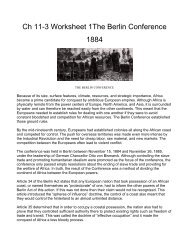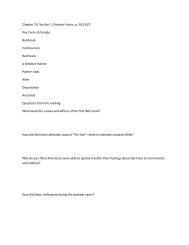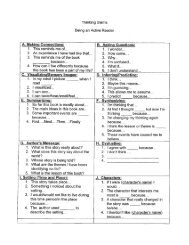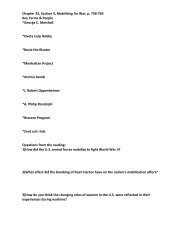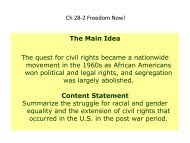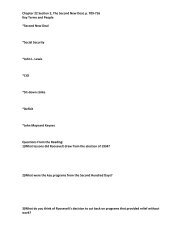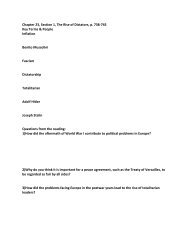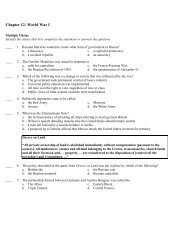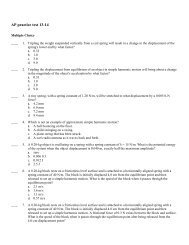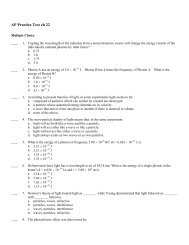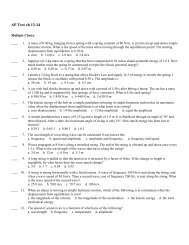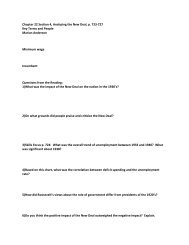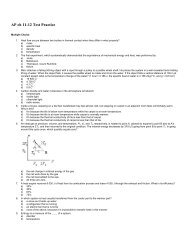22.3 Reading Guide
22.3 Reading Guide
22.3 Reading Guide
You also want an ePaper? Increase the reach of your titles
YUMPU automatically turns print PDFs into web optimized ePapers that Google loves.
Name ___________________________ Class ___________________ Date _____________<br />
Chapter 22<br />
Earth’s Interior<br />
Section <strong>22.3</strong> Rocks and the Rock Cycle<br />
(pages 670–675)<br />
This section describes how rocks are classified. It also explains how rocks<br />
change form in the rock cycle.<br />
<strong>Reading</strong> Strategy (page 670)<br />
Comparing and Contrasting After you read, compare groups of rocks<br />
by completing the table. For more information on this <strong>Reading</strong><br />
Strategy, see the <strong>Reading</strong> and Study Skills in the Skills and<br />
Reference Handbook at the end of your textbook.<br />
Groups of Rocks<br />
Rock Group Formed by Example<br />
Igneous Cooling of magma or lava<br />
Possible answers include<br />
granite, basalt, and gabbro.<br />
Sedimentary Compression and cementing Sandstone<br />
together of sediment<br />
Metamorphic Heat and pressure<br />
Possible answers include slate,<br />
schist, and gneiss.<br />
© Pearson Education, Inc., publishing as Pearson Prentice Hall. All rights reserved.<br />
Classifying Rocks (page 670)<br />
1. Circle the letters of the major groups into which rocks are classified.<br />
a. sedimentary b. igneous<br />
c. calcite d. metamorphic<br />
2. Scientists divide rocks into groups based on how they form .<br />
Igneous Rock (page 671)<br />
3. Arock that forms from magma is called a(n) igneous rock .<br />
4. A mixture of molten rock and gases that forms underground is<br />
called magma .<br />
5. What is lava? Lava is magma that flows onto the surface.<br />
6. Is the following sentence true or false? Igneous rock is formed<br />
when molten material cools and solidifies either inside Earth or<br />
at the surface.<br />
true<br />
Match each type of igneous rock to its characteristics. Each type of rock will<br />
have more than one characteristic.<br />
Igneous Rock Characteristic<br />
a, d, f 7. intrusive rock a. Forms underground<br />
b, c, e 8. extrusive rock b. Forms at Earth’s surface<br />
c. Has a fine-grained texture<br />
d. Has a coarse-grained texture<br />
e. Cools quickly<br />
f. Cools slowly<br />
Physical Science <strong>Reading</strong> and Study Workbook ■ Chapter 22 269
© Pearson Education, Inc., publishing as Pearson Prentice Hall. All rights reserved.<br />
Name ___________________________ Class ___________________ Date _____________<br />
Chapter 22<br />
Earth’s Interior<br />
Sedimentary Rock (pages 672–673)<br />
9. The process of breaks down rock at<br />
Earth’s surface.<br />
10. When sediment is squeezed and cemented together,<br />
sedimentary rocks are formed.<br />
11. Circle the groups into which geologists classify sedimentary rocks.<br />
a. clastic rocks<br />
b. foliated rocks<br />
c. organic rocks<br />
d. chemical rocks<br />
12. Sedimentary rocks formed from broken fragments of other rocks<br />
are called clastic rocks.<br />
13. Is the following sentence true or false? Clastic rocks are classified<br />
mainly based on the number of fragments they have.<br />
false<br />
weathering<br />
14. Minerals that precipitate out of solution form<br />
chemical sedimentary rocks .<br />
Metamorphic Rock (page 674)<br />
15. Circle the ways a rock can be transformed into a metamorphic rock.<br />
a. by heat<br />
b. by precipitation<br />
c. by pressure<br />
d. by chemical reaction<br />
16. Where do most metamorphic rocks form?<br />
deep underground.<br />
Most metamorphic rocks form<br />
17. Is the following sentence true or false? Metamorphism can change<br />
the mineral content and texture of a rock.<br />
true<br />
18. Metamorphic rocks with crystals arranged in parallel bands or<br />
layers are called foliated rocks.<br />
The Rock Cycle (pages 674-675)<br />
19. Circle the letters of the sentences that are true about the rock cycle.<br />
a. A metamorphic rock that melts and cools to form a new rock<br />
becomes an igneous rock.<br />
b. Forces within Earth and at the surface cause rocks to change<br />
form in the rock cycle.<br />
c. In the rock cycle, rocks may wear away, undergo<br />
metamorphism, or melt and form new igneous rock.<br />
d. The rock cycle is a series of processes in which rocks change<br />
from one type to another continuously.<br />
270 Physical Science <strong>Reading</strong> and Study Workbook ■ Chapter 22



